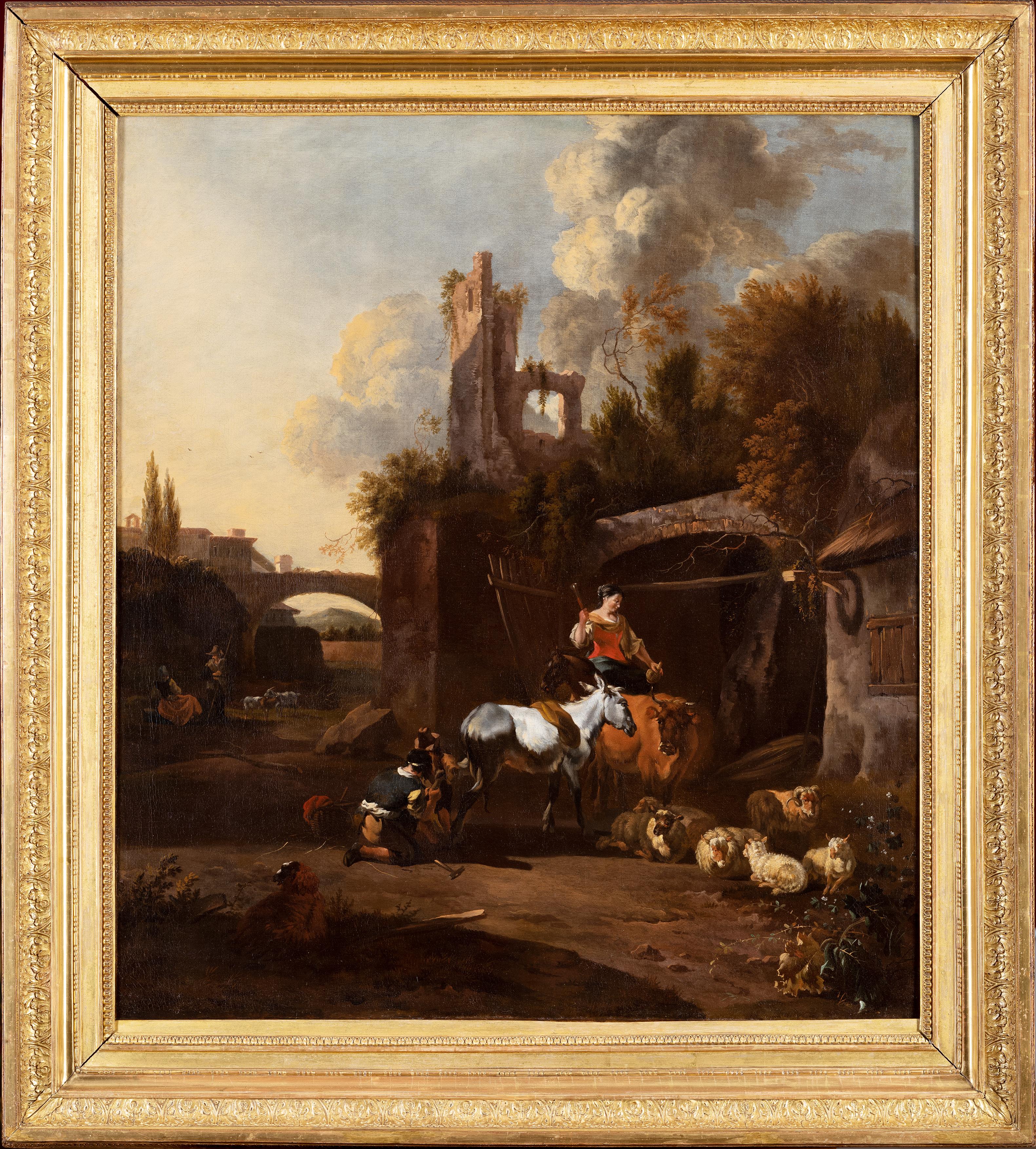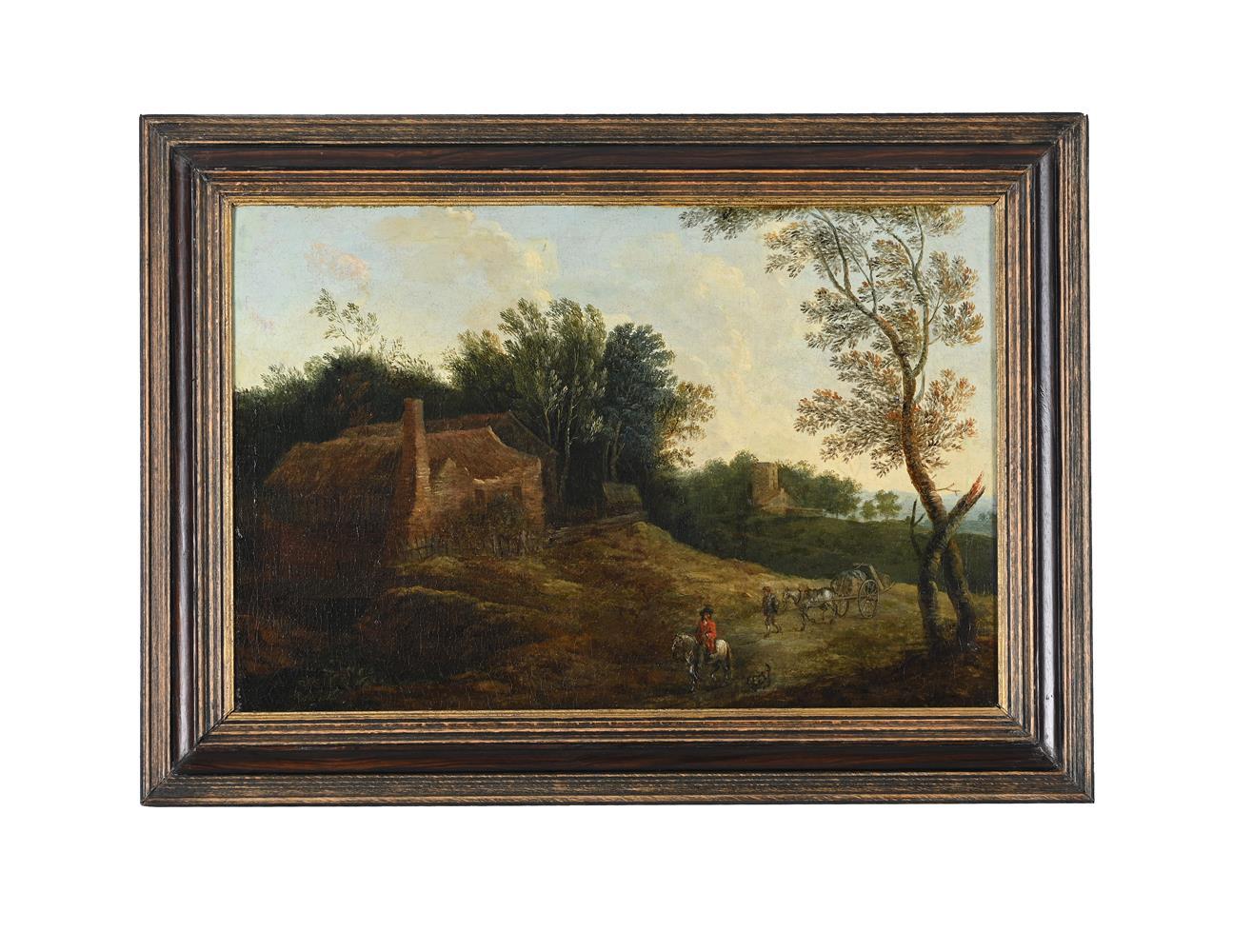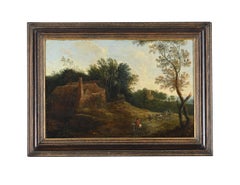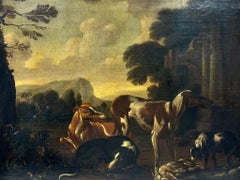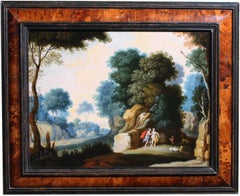Items Similar to Travellers and Dogs in Landscape, Ruins on Right - Dutch Old Master oil painting
Want more images or videos?
Request additional images or videos from the seller
1 of 16
Travellers and Dogs in Landscape, Ruins on Right - Dutch Old Master oil paintingCirca 1660
Circa 1660
$17,541.38
$21,926.7320% Off
£12,800
£16,00020% Off
€14,933.28
€18,666.6020% Off
CA$24,027.31
CA$30,034.1420% Off
A$26,723.62
A$33,404.5220% Off
CHF 13,954.24
CHF 17,442.8020% Off
MX$325,197.98
MX$406,497.4720% Off
NOK 178,216.96
NOK 222,771.2020% Off
SEK 167,136.07
SEK 208,920.0820% Off
DKK 111,452.78
DKK 139,315.9820% Off
Shipping
Retrieving quote...The 1stDibs Promise:
Authenticity Guarantee,
Money-Back Guarantee,
24-Hour Cancellation
About the Item
This lovely Dutch Old Master oil painting is attributed to artist Pieter Wouwerman. Painted circa 1660 it is figurative landscape with horseback travellers and their dogs in the foreground with ruins on their right. Beyond is a river and hilly landscape, all in the fading light of approaching dusk. There are some superb details making this an excellent Dutch Golden Age oil painting.
Provenance: Devonshire estate.
Condition. Oil on canvas, 24 inches by 20 inches and in good condition.
Frame. Housed in a complementary gilt frame, 31 inches by 27 inches and in good condition.
Pieter Wouwerman (1623-1682) was a Dutch Golden Age landscape painter. He was born in Haarlem. According to Arnold Houbraken, a biographer of artists from the Dutch Golden Age, Pieter Wouwerman was the brother of the landscape painters Jan and Philips Wouwerman, who, like his more famous brother, made a living selling Italianate landscapes in the manner of Pieter van Laer. Houbraken mentioned a story in which Philips Wouwerman burned his sketchbooks before his death, so that his brother wouldn't be able to use them and cash in on his name. Houbraken claimed that the story was malicious gossip, but he had heard another story that was probably closer to the truth. Apparently when Pieter van Laer returned to Haarlem, his art was worth less than what he received in Rome, but he wouldn't lower his price. When a landscape that Laer made was considered too expensive, the buyer contracted the then young Philips Wouwermans to copy it, which he did quite well. The success of this transaction launched the career of the young Wouwermans at the expense of Pieter van Laer, and Houbraken heard from Michiel Carré who in turn heard it from Pieter Gerritsz van Roestraten and Jacob de Wet that guilt forced Wouwerman to burn the proof of all of his copies before he died. According to the RKD (Netherlands Institute for Art History), he was a student of Roelant Roghman, his older brother Philips, and his father Pouwels. He left Haarlem for Amsterdam in 1657. He died in 1682 in Amsterdam.
- Attributed to:Pieter Wouwerman (1623 - 1682, Dutch)
- Creation Year:Circa 1660
- Dimensions:Height: 27 in (68.58 cm)Width: 31 in (78.74 cm)Depth: 2 in (5.08 cm)
- Medium:
- Movement & Style:
- Period:Mid-17th Century
- Condition:
- Gallery Location:London, GB
- Reference Number:1stDibs: LU853113420152
About the Seller
5.0
Platinum Seller
Premium sellers with a 4.7+ rating and 24-hour response times
1stDibs seller since 2018
453 sales on 1stDibs
Typical response time: 1 hour
- ShippingRetrieving quote...Shipping from: London, United Kingdom
- Return Policy
Authenticity Guarantee
In the unlikely event there’s an issue with an item’s authenticity, contact us within 1 year for a full refund. DetailsMoney-Back Guarantee
If your item is not as described, is damaged in transit, or does not arrive, contact us within 7 days for a full refund. Details24-Hour Cancellation
You have a 24-hour grace period in which to reconsider your purchase, with no questions asked.Vetted Professional Sellers
Our world-class sellers must adhere to strict standards for service and quality, maintaining the integrity of our listings.Price-Match Guarantee
If you find that a seller listed the same item for a lower price elsewhere, we’ll match it.Trusted Global Delivery
Our best-in-class carrier network provides specialized shipping options worldwide, including custom delivery.More From This Seller
View AllTravellers near Ruins in a Landscape - Dutch Old Master art figural oil painting
By Pieter Wouwerman
Located in London, GB
This lovely Dutch Old Master oil painting is attributed to artist Pieter Wouwerman. Painted circa 1660 it is figurative landscape with horseback travellers and their dogs in the foreground approaching ruins on their left. Beyond is a river snakes through the landscape, beneath the fading light of approaching dusk. There are some superb details making this an excellent Dutch Golden Age oil painting...
Category
Mid-17th Century Old Masters Landscape Paintings
Materials
Oil
Travellers in Wooded Landscape - Dutch 17th century art Old Master oil painting
By Jan Wijnants (circle)
Located in London, GB
An original, very large Dutch Old Master oil on canvas which is attributed to circle of Jan Wijnants and was painted circa 1680. The huge canvas is in good clean condition and depicts a wooded landscape with travellers passing through. A delightful very large country house old master painting.
Provenance. Private collection, Christies.
Condition. Oil on canvas. Very large, image size is 53 inches by 41 inches and in good clean condition.
Framed size is 63 by 51 inches. The carved original 17th Century wood frame...
Category
17th Century Old Masters Landscape Paintings
Materials
Oil
Italian Landscape with Travellers - Dutch Golden Age 17thC art oil painting
Located in London, GB
This superb Dutch Golden Age Old Master landscape oil painting is attributed to Jacob van der Croos. Painted circa 1670 it is an Italianate landscape with figures and their animals i...
Category
17th Century Old Masters Landscape Paintings
Materials
Oil
$17,541 Sale Price
20% Off
Landscape with Ruins and Figures - British 18thC Old Master art oil painting
By Richard Wilson
Located in London, GB
This superb British 18th century Old Master oil painting is attributed to circle of noted landscape artist Richard Wilson. Painted circa 1750 it is a stunning light, bright and airy expansive panoramic landscape. There is a river in the foreground and mountains in the background. On the left of the river stands some ruins and on the right, figures are resting under the trees. The palette of blues, greens and very varied and rich with some lovely pinky brown tones for the land on the right. The brushwork is also delicate but confidently executed. A superb example of a British Old Master landscape oil painting, finished off in a carved and gilt wood English Rococo frame with name plate.
Provenance. The Asbjorn Lunde Foundation, Inc. Throughout his long life, Mr. Lunde supported more than forty museums in his native New York, across the United States, and in Europe with loans, gifts, and funding. Mr. Lunde was a proud New Yorker with roots in Norway. He was keenly interested in nineteenth-century Scandinavian and Swiss landscape painting, Old Master painting, and Asian decorative arts.
According to an old label to the reverse, the present painting was once owned by James Northcote (1746-1831) who gave it to William Hillman on 25th May 183(0?)
Property of the Bacot family.
Christies stamps verso.
Watson Gallery London. Remains of label verso.
Condition. Oil on canvas, 26 inches by 18 inches and in good condition.
Frame. Housed In a carved and gilt wood English Rococo frame bearing Richard Wilson name plate, 33 inches by 25 inches and in good condition.
Richard Wilson RA...
Category
1750s Old Masters Landscape Paintings
Materials
Oil
$24,119 Sale Price
20% Off
Travellers and Carriage in Landscape Dutch 17th century Golden Age oil painting
Located in London, GB
This superb Dutch Old Master Golden Age oil painting is attributed to Pieter Bodding van Laer. Painted circa 1635 the composition is a group of travellers who have stopped to rest. I...
Category
17th Century Old Masters Landscape Paintings
Materials
Oil
$13,156 Sale Price
20% Off
Italian Landscape - Dutch Old Master art Grand Tour landscape oil painting
Located in London, GB
This simply stunning large Old Master landscape oil painting is attributed to noted Dutch artist Adriaen van Diest. Painted circa 1700 this Mediterranean Italian landscape painting has everything; A really interesting landscape with land, river, sea and mountains, interesting figures and cattle and a wonderful sky with fading light. The details and the capturing of the light make this a really fantastic Dutch Old Master country house Grand Tour oil painting. Irresistible.
Provenance. Dorset estate.
Condition. Oil on canvas, 42 inches by 20 inches and in good condition.
Frame. Housed in an English carved giltwood frame, 50 inches by 28 inches framed and in good condition.
Adriaen van Diest (1655-1704) was born in the Hague in the Netherlands. Like his father and his brother, he pursued a career as a marine painter, that is, a painter of seascapes and sailing ships. In 1673, attracted by the thriving English market for portraits and marine paintings, he joined the exodus of Dutch artists leaving to work in England. It is thought that his master was Willem van de Velde the Younger...
Category
Early 1700s Old Masters Landscape Paintings
Materials
Oil
$21,378 Sale Price
20% Off
You May Also Like
Van der Bent, Southern Landscape with woman animals, Dutch Old Master, Berchem
Located in Greven, DE
17th Century Old Master, Figurative and Landscape Painting by Jan Van der Bent
So far, little is known about the life and work of Jan van der Bent. He was...
Category
17th Century Baroque Landscape Paintings
Materials
Canvas, Oil
$17,732 Sale Price
20% Off
Fine 17th Century Flemish Old Master Oil Painting Travellers Country Landscape
Located in Cirencester, Gloucestershire
Travellers in a Country Landscape
circle of Jacques d'Arthois (Flemish 1613-1686)
oil on canvas, framed
frame: 13.5 x 18.5 inches
canvas: 11 x 16 inches
provenance: private collectio...
Category
17th Century Old Masters Landscape Paintings
Materials
Oil
Fine 1700's Italian Old Master Oil Painting Hunting Dogs with Game, Roman Ruins
Located in Cirencester, Gloucestershire
Artist/ School: Italian School, early 18th century
The painting is almost certainly from the circle of the Italian Baroque painter known as 'Rosa da Napoli', Jacob Roos (Rome 1682-Na...
Category
Early 18th Century Baroque Landscape Paintings
Materials
Oil
Landscape with figures, workshop of Paul Bril, Italian school 17th Century
By Paul Bril
Located in PARIS, FR
Idyllic landscape with myhological story of Cephalus and Procris
Early 17th century Italian school
Workshop Of Paul Bril (Antwerp, 1554 - Roma, 1626)
Oil on poplar panel: H. 28 cm (1...
Category
Early 17th Century Old Masters Landscape Paintings
Materials
Poplar, Oil
Mid-18th-Century Dutch School Landscape With Travellers, Distant View & Building
Located in Cheltenham, GB
This splendid mid-18th-century Dutch landscape painting depicts a view with travellers before distant rolling hills.
Amid the long shadows of early evening, a travelling party rests...
Category
1750s Dutch School Landscape Paintings
Materials
Wood Panel, Oil
Dutch or Flemish Landscape with Figures & Animals
Located in Milford, NH
A beautifully detailed late 17th or early 18th century Dutch or Flemish landscape with cows grazing in the water, goats, dogs, and other animals near the water’s edge, under the watchful eye of the herdsmen, on a backdrop of rolling hills and trees. Oil on wood panel, unsigned, and housed in a Rudolph...
Category
Late 17th Century Flemish School Landscape Paintings
Materials
Oil, Wood Panel
More Ways To Browse
Dutch Golden Age
Oil Painting Ruins
17th Century Dutch Landscape
Dutch Golden Age Painting
17th Century Dutch Landscape Paintings
Dutch Oil Painting River
Antique Sketchbooks
Gossip Painting
Guilt Frame
Philips Wouwerman
Van Laer
Set Of Four Oil Paintings
Antique Winter Scene
Early 20th Century Ship Paintings
Miniature Building
Sail Boat Painting
St Frank
California Carmel Landscape Paintings

